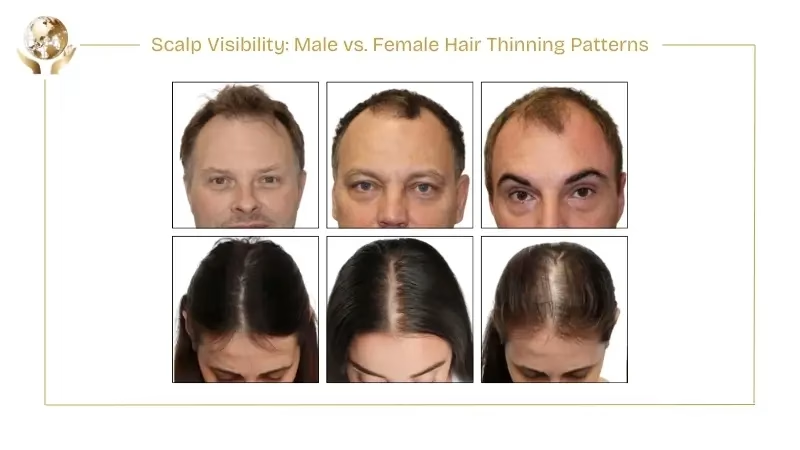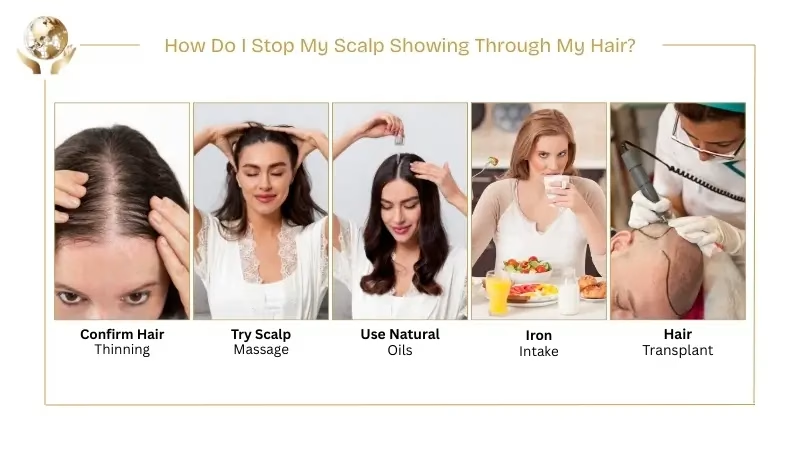My Hair Is So Thin I Can See My Scalp | Causes & Solutions
“My hair is so thin I can see my scalp’’ is a phrase heard from countless individuals. This visible thinning gradually or suddenly increases scalp exposure under natural light, after washing, and during styling.
Hair thinning is a common issue that affects both men and women. They often search for answers, treatments, and reassurance to manage their condition.
In this article, we’ll explore the key reasons behind hair thinning and share effective ways to restore volume, hide visible scalp, and promote overall hair health. If you want to know more about your hair condition, let’s dive into this ultimate guide.
Why Is My Hair So Thin I Can See My Scalp?
Thinning hair and increased scalp visibility range from biological factors to external damage. There are several factors that contribute to hair thinning, including:

- Genetics: It plays an important role in both male and female pattern baldness. If your family members have experienced hair loss, you may be likely to develop it too.
- Hormonal Changes: Hormones, particularly DHT, is involved in hair thinning by affecting the hair follicles causing them to shrink. Menopause can worsen this process further due to decreased estrogen levels in women. This weakens the protective effect on the hair.
- Nutritional Deficiencies: If the body has low levels of iron, biotin, zinc, or vitamin D, they can weaken the hair follicles. Over time, it will also diminish the hair density.
- Stress & Lifestyle: Chronic stress, lack of sleep, smoking, or sudden weight loss can trigger a phase called telogen effluvium. It is a zone where hair enters the shedding phase prematurely.
- Overstyling & Heat Damage: Regular use of heat tools, tight hairstyles, or harsh chemical treatments can cause hair breakage. This will damage the follicles and make them look thinner.
- Scalp Conditions: Dandruff, psoriasis, and seborrheic dermatitis are some of the conditions that hinder healthy hair growth and inflame the scalp.
- Aging: With aging, hair becomes finer, and changes in the follicle size occur. As a result, the collagen production reduces, affecting the hair structure.
Scalp Visibility: Male vs. Female Hair Thinning Patterns
Scalp visibility is commonly observed in both men and women, but its progression, causes, and patterns often vary. Here’s how it typically appears:
| Feature | In Females | In Males |
| Typical Pattern | Thinning around the crown, often without full bald spots. | Androgenic alopecia (male pattern baldness) is most common, starting with a receding hairline or bald spot at the crown. |
| Common Causes | Telogen effluvium (temporary, reversible hair loss), Vitamin D deficiency slowing follicle activity. | DHT (Dihydrotestosterone) sensitivity (main cause of androgenic alopecia). |
| Observed Changes | Visibly thinner scalp or hairline, reduced hair density. | Hair gets thinner if it’s long. Scalp visibility increases under light or when wet. |
| Progression | Sudden | Gradual |

How Do I Stop My Scalp Showing Through My Hair?
If your scalp is visible through your hair, it is a sign of hair thinning, not necessarily indicating permanent hair loss. The key to solving this issue is to stop or reverse the thinning process.
Here are some effective steps that help stop your scalp from showing through your hair or support regrowth:

Confirm Hair Thinning
Many people mistakenly consider fine hair or lighting effects as thinning. Make sure you examine your hair density in natural light and compare photos. Also, consult a dermatologist for expert advice.
Try Scalp Massage
Regular scalp massages can:
- Increase blood circulation to the follicles.
- Lower the stress levels by reducing the cortisol hormone.
- Promote a healthier hair growth environment.
It’s better to use fingertips or a scalp massager every 5 to 10 minutes daily.
Use Natural Oils & Serums
There are many oils and serums that contain compounds to boost scalp circulation, reduce inflammation, or nourish follicles. These include:
- Coconut oil
- Avocado oil
- Andiroba oil
- Black seed oil elixirs
- Peppermint oil
- Lavender oil
- Rosemary oil
- Rosehip oil
These oils and serums often consist of natural ingredients such as plant extracts and essential oils that nourish follicles and help prevent breakage.
See Also: How To Use Batana Oil For Hair Growth
Protein And Iron Intake
Low iron levels can lead to anemia and cause excessive shedding of hair. Dietary sources are recommended to enhance protein and iron levels in the body. It includes:
- Protein Sources: Eggs, lentils, chicken, tofu.
- Iron: Spinach, red meat, pumpkin seeds.
Apart from that, you can also take supplements but under medical supervision.
Consider A Hair Transplant
Development of bald patches is likely a sign of male pattern baldness. Due to which hair transplant option is considered. Keep in mind:
- It is a costly procedure and does not guarantee full regrowth.
- It often requires long-term maintenance, which may include products like minoxidil to support existing hair and optimize results.
- Consult a qualified hair restoration expert before making a decision.
See Also: Hair Transplant in Turkey
How Can I Tell If I Really Have Female Pattern Baldness?
There are many signs of female pattern baldness, which include:
- Gradual Thinning On The Top Of The Head: It is the most common sign in females, they rarely develop receding hairlines or go completely bald in the same way males do.
- Widening Part Line: The central hair parts slowly and noticeably become wider over time.
- Increased Hair Shedding: This is often seen in your hairbrush, on your pillow, and in the shower drain. If there is no new hair growth to replace it, thinning becomes noticeable.
- Hair Appears Less Dense: The ponytail may look thinner and the scalp becomes visible under light.
- Miniaturized Hair Strands: With the passage of time, thick hair turns into finer, shorter hair, which weakens overall hair volume.
How To Hide A Visible Scalp?
You can use several techniques to hide your scalp while waiting for underlying treatments to show effects. It’s better to change the way you style your hair.
- A side parting creates more volume than a center parting.
- Strategic cuts, such as bobs, gentle layers, or fringes mask the thinning hair.
- Shorter styles are more preferred over very long hair, which is likely to flatten.
- Blow-dry your hair with your head tilted downwards to create volume at the roots.
- Use headscarves, hairbands, or clips to wear to style your hair differently.
- Add waves and texture to your hair with styling products.
See Also: Classic Hair Styles for Thin Hair
Scalp Visibility Factors & Their Impact on Hair Appearance
The table below shows how different elements affect scalp visibility and what they actually mean for your hair health.
| Factor | How It Affects Hair Appearance | Temporary or Permanent |
| Wet Hair | Clumps hair together, showing more scalp | Temporary |
| Lighting (Overhead/Flash) | Highlights thin areas, especially at the part line | Temporary |
| Hair Length | Long hair may weigh down and flatten at the roots | Temporary |
| Fine Hair Texture | Less volume per strand = more visible scalp | Genetic but manageable |
| Oily Scalp | Makes hair look flat and separated | Temporary |
| Product Buildup | Weighs hair down, reducing volume | Temporary |
| Straight Vs Curly Hair | Straight hair reflects more light and shows scalp more clearly | Varies |
| Scalp Tone Contrast | Light scalp + dark hair makes thinning more noticeable | Permanent unless colored |
Best Hair Care Tips For Thin Hair And Visible Scalp
Caring for thin hair requires a special approach to maintain its health and appearance. There is a range of essential hair care tips that are specific for thin hair.

- Gentle, Sulfate-Free Shampoos: Thin hair is likely to get damaged. For this, you can use a gentle, sulfate-free shampoo. Sulfates will remove the natural oils from the hair, making it appear flat. Opting for sulfate-free shampoos ensure a healthy scalp environment and prevent excessive drying of hair strands.
- Lightweight Conditioners: Look for conditioners that are made for fine or thin hair. Make sure to apply the conditioner from mid-length to ends, leaving the scalp to prevent scalp visibility.
- Regular Scalp Exfoliation: It is essential to avoid buildup, dead skin cells, and excess oil accumulation. This can clog the follicles and restrain healthy hair growth. Use a scalp exfoliating treatment or a soft bristle brush to gently massage the scalp. This will improve the circulation that leads to hair growth stimulation.
- Proper Detangling Techniques: Thin hair breaks easily, so you must detangle it first. Begin applying a lightweight conditioner or using a detangling spray to ease the work. Use a wide-toothed comb or a brush with soft bristles. Make sure to gently work through knots to reduce hair breakage.
See Also: Is Hyaluronic Acid Good for Hair?
What Affects Hair Density?
Hair density refers to the number of hair strands per square inch of your scalp. There are several factors that show how the hair appears dense.
- Genetics: If thin hair runs in the family, you will possibly have low density hair.
- Age: Hair density gradually declines with age. According to a 2020 study,
- People in their 20s had about ~1,064 hairs/sq inch
- People in their 60s had about ~1,004 hairs/sq inch
- Diet & Nutrition: If there is a lack of protein, iron, zinc, or vitamins in the diet, it reduces the density of hair. This will disrupt the hair growth cycle.
- Hormonal Shifts: This is observed during pregnancy, menopause, or thyroid imbalances. It leads to visible thinning of hair.
- Hair Care Practices: People who experience frequent heat styling, chemical treatments or tight hairstyles weaken the hair strands and damage the follicles. Also, the ability of the follicles to produce strong, dense hair reduces with time.
How To Check Your Hair Density?
If you are noticing scalp thinning or visibility, it’s important to understand your hair density. Below are the quickest and most effective tests to check hair density at home.

Hair Density Test No.1: The Ponytail Method
This method works best if you have medium to long hair.
- Make sure to tie your hair into a ponytail.
- With the help of soft measuring tape, measure the circumference.
| Hair Density | Measurement |
| Low Density | Less than 2 inches |
| Medium Density | Around 3 inches |
| High Density | 4 inches or more |
Hair Density Test No. 2: The Visible Scalp Check
This test requires natural light to assess the visibility of your scalp.
| Scalp Appearance | Hair Density Interpretation |
| Scalp clearly visible under natural light | Likely low hair density |
| Thinning visible, but no extra hair shedding | Often linked to fine hair, not actual hair loss |
| Hair appears sparse mostly at the roots | May indicate low density, not necessarily balding |
Best Treatments For Thinning Hair
Below are some evidence-based treatments for thinning hair. These include topical treatments to professional procedures and promote long term hair growth.

Topical Drug
Minoxidil is a recommended topical drug for hair loss treatment. It helps by prolonging the hair growth phase and can increase the diameter of hair strands, promoting thicker-looking hair
You can find it in liquid or foam form and apply it directly onto the scalp. It is advised to use this topical drug daily for up to nine months for better results.
Oral Medication
Finasteride is an oral medication primarily for men with male pattern baldness. It is generally not prescribed to women of childbearing age due to the risk of birth defects.
This medication works by preventing testosterone conversion into DHT. It has positive results that makes a huge difference in thinning or balding hair.
Platelet-Rich Plasma Injections
This treatment is repeated for three months, and requires a follow-up every year. In this procedure, a large concentration of your blood is injected into the scalp to stimulate hair growth.
Laser Light Treatments
There are certain devices that emit low-level LED laser light to stimulate hair growth. These tools are available in combs or helmets, and you can use them daily at your home. The prices vary from a few hundred to a few thousand dollars.
Supplements
The supplements are very expensive but it’s okay to try them. If they don’t interfere with your medications, then it’s safe to use them.

This article is medically reviewed by Head Physician & Aesthetic Dr. Bulent
See Our Doctors & Surgeons
What not to do with thin, fine hair?
Avoid over washing, tight hairstyles, backcombing, excessive heat styling, or heavy styling products.
Can you increase hair density?
Yes, it can be increased through DHT blockers, topical treatments, balanced diet, microneedling, or scalp massages.
What is the best haircut for very thin fine hair?
Layered bob, blunt bob, textured cut, and avoid long or overly-layered cuts.
Is short or long hair better for thinning hair?
Short hairstyles are better for thinning hair as they are easy to style and maintain. They give out the appearance of a thicker volume.
Should you brush fine, thin hair?
Yes, better to do it with the right brush. Use a wide-tooth comb or boar-bristle brush.
What not to use on thinning hair?
Avoid heavy oils, sulfates, high-heat tools, and alcohol-based styling products.
Should people with thin hair get layers?
Yes, soft or strategic layers do the job. Make sure to avoid too short layers and consult a stylist regarding thin or aging hair texture.
Can my thin hair become thick again?
It depends on the cause that include genetic thinning, temporary thinning, and using treatments to reverse it into thick hair.






